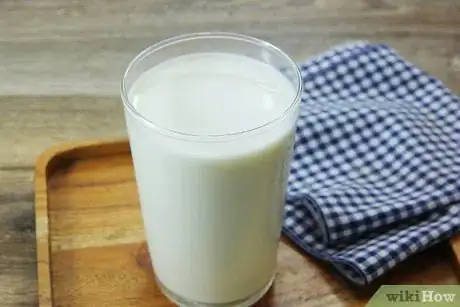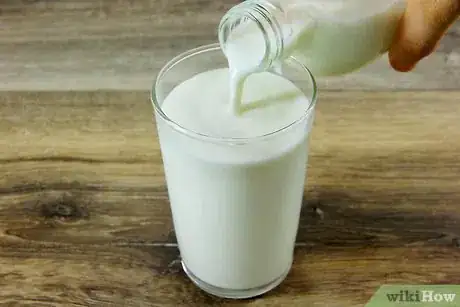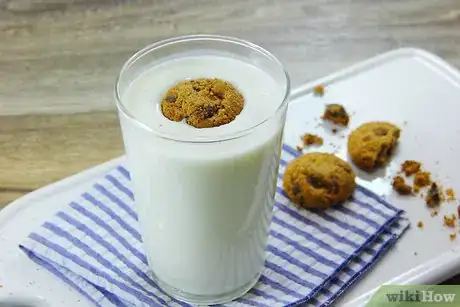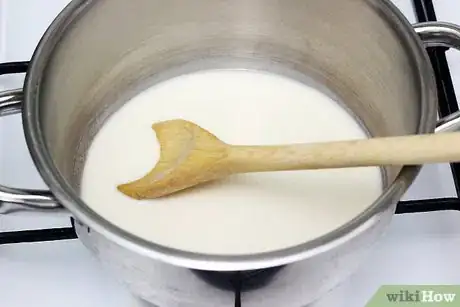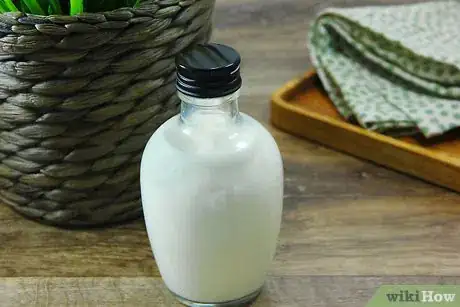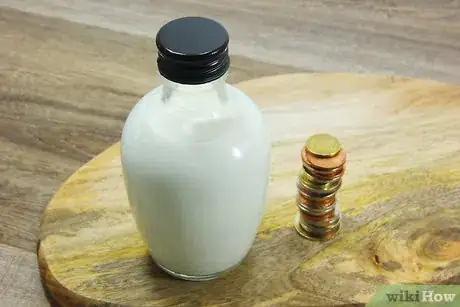This article was co-authored by wikiHow Staff. Our trained team of editors and researchers validate articles for accuracy and comprehensiveness. wikiHow's Content Management Team carefully monitors the work from our editorial staff to ensure that each article is backed by trusted research and meets our high quality standards.
There are 8 references cited in this article, which can be found at the bottom of the page.
This article has been viewed 24,075 times.
Learn more...
Drinking milk is a great way for children and adults to get calcium and protein, which can lead to strong bones, healthy teeth and glowing skin. However, many people cannot drink cow milk because they are lactose intolerant. In fact, millions of people suffer from a cow milk allergy, and many of the same people also react negatively to goat, sheep and nut milk. There is a viable alternative: camel milk.
Steps
Drinking Camel Milk Plain
-
1Enjoy camel milk as its own beverage. Camel milk tastes similar to cow milk, so there is no need to add anything to offset the taste. It is also healthier than milk from other animals because it has less lactose, the sugar found in milk. Make sure to only drink the pasteurized version, as consuming raw camel milk can leave you exposed to animal-based pathogens.[1]
-
2Consume camel milk at any time of day. Camel milk is a filling beverage, which means it can be had as a snack whenever you are craving it. Many people drink camel milk as part of their breakfast, while others enjoy it best as a midnight treat.[2]
- There is no limit to how much camel milk you can have in a day.
- Camel milk is effective when consumed midday, as it can give you a boost of energy.
Advertisement -
3Use camel milk before or after exercising. Camel milk provides the energy and nutrition needed to get through a long day. Drinking it before or after working out is a great way to keep your heart healthy. Camel milk can both get you ready for a strenuous workout and replenish your body after you've hit the gym. [3]
- The enzymes found in camel milk help your body fight off bacteria.
Mixing Camel Milk with other Drinks and Food
-
1Put camel milk in your coffee. Camel milk mixes seamlessly with coffee and is a great way to kickstart your day. A healthy way to keep your productivity up, camel milk is perfect for anyone feeling sluggish mid-week.[4]
-
2Dip cookies into camel milk. Camel milk contains a small hint of saltiness, which helps it harmonize with cookies. Chocolate chip cookies work well, as dipping them in camel milk creates a delicious and balanced sweet-and-salty snack.[5]
- You can't go wrong with other cookies, as the sweetness is what is key to having it with camel milk.
-
3Cook with camel milk when recipes call for milk. Camel milk can be used in place of cow milk when it comes to cooking. Any dish that you would prepare using cow milk can be made with camel milk. This includes various cheeses and yogurt.[6]
- Camel milk makes Feta cheese in particular especially tasty.
Buying and Storing Camel Milk
-
1Try to find camel milk in health food stores. Though camel milk is not yet widely available in the United States, it can be found in some grocery chains and health food stores. Whole Foods sells the product in its stores across the country, while California is home to many smaller shops that sell camel milk.
-
2Buy camel milk online if you can't find any in local stores. The easiest way for most people to get camel milk is to purchase it on the internet, as many companies that make the product also sell it online. Keep in mind that camels produce less milk than other animals, like cows, so it is not cheap.[7]
- Camels can produce up to two gallons of milk per day, while cows can give around 12 gallons of milk per day.
-
3Refrigerate the camel milk you buy. Camel milk must be stored at 40 degrees Fahrenheit or colder. Camel milk generally has a longer shelf life than cow milk, so it can be kept in your fridge for a few weeks without spoiling.[8]
- Fresh camel milk can keep for up to a week, while cow milk can turn sour within two days.
-
4Purchase camel milk carefully. Camel milk is still something of a niche beverage, so shop for it smartly. Whereas a gallon of cow milk goes for a little more than three dollars on average, a 16-ounce bottle of camel milk can run you about 18 dollars. Camel milk is also available in powder form, but a 200-gram packet can costs nearly 80 dollars.[9] These prices do not account for taxes or shipping and handling fees.
References
- ↑ https://www.mindbodygreen.com/articles/is-camel-milk-healthy-what-does-it-taste-like
- ↑ https://www.mindbodygreen.com/articles/is-camel-milk-healthy-what-does-it-taste-like
- ↑ https://www.naturallivingideas.com/camel-milk/
- ↑ https://www.washingtonpost.com/news/voraciously/wp/2018/06/13/move-aside-pea-milk-camel-milk-is-the-new-rage/?utm_term=.287a331a38f7
- ↑ https://www.washingtonpost.com/news/voraciously/wp/2018/06/13/move-aside-pea-milk-camel-milk-is-the-new-rage/?utm_term=.435ff9d34022
- ↑ https://www.bloomberg.com/news/features/2018-05-23/the-world-wants-more-camel-milk-australia-can-help
- ↑ https://www.theatlantic.com/health/archive/2014/08/a-nice-tall-glass-of-camels-milk/376042/
- ↑ http://www.lrrd.org/lrrd19/6/seif19086.htm
- ↑ https://www.cnn.com/2018/11/25/health/camel-milk-in-the-us-intl/index.html
